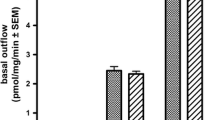Abstract
Endogenous amino acid release was examined in rat cerebellar primary cultures comprising more than 95% of glutamatergic granule cells. Eighteen amino acids were determined in the cell extracts and in the release fractions by high performance liquid chromatography, using precolumn derivatization witho-phthaldialdehyde and separation on a reverse-phase column using a multi-step gradient system of two solvents (0.1 M Na+acetate, pH 7.2/methanol: tetrahydrofuran, 97:3). The fluorimetric response was linear, at least in the range of 2–162 pmol, for all the amino acids analysed, with a detection limit of 1 pmole. We observed a good reproducibility in within-assay and between-assay coefficients of variation of the retention times and fluorescence yield. When cultured granule cells were exposed to the excitatory amino acid receptor agonist quisqualic acid (50 μM), we observed a net increase in the release of glutamate (3 fold over the baseline) and a smaller increase in that of aspartate (2 fold) and taurine (1.6 fold). Other amino acids were not significantly affected. GABA levels were below detection limits, due to the minimal number of GABAergic neurons present in the cultures.
Similar content being viewed by others
References
Roth, M. 1971. Fluorescence reaction for amino acids. Anal. Chem. 43:880–882.
Lindroth, P., and Mopper, K. 1979. High performance liquid chromatographic determination of subpicomole amounts of amino acids by precolumn fluorescence derivatization with o-phthaldialdehyde. Anal. Chem. 51:1667–1674.
Hodgin, J. C. 1979. The separation of pre-column o-phthalaldehyde derivatized amino acids by high performance liquid chromatography. J. Liq. Chromatogr. 2:1047–1059.
Jones, B. N., Pääbo, S., and Stein, S. 1981. Amino acid analysis and enzymatic sequence determination of peptides by an improvedo-phthaldialdehyde precolumn labeling procedure. J. Liq. Chromatogr. 4:565–586.
Umagat, H., and Kucera, P. 1982. Total amino acid analysis using pre-column fluorescence derivatization. J. Chromatogr. 239:463–474.
Jones, B. N., and Gilligan, J. P. 1983.o-Phthaldialdehyde precolumn derivatization and reversed-phase high-performance liquid chromatography of polypeptide hydrolysates and physiological fuuids. J. Chromatogr. 266:471–482.
Cooper, J. D. H., Ogden, G., McIntosh, J., and Turnell, D. C. 1984. The stability of theo-phthalaldehyde/2-mercaptoethanol derivatives of amino acids: an investigation using high-pressure liquid chromatography with a precolumn derivatization technique. Anal. Biochem. 142:98–102.
Ali Qhreshi, G., Fohlin, L., and Bergström, J. 1984. Application of high-performance liquid chromatography to the determination of free amino acids in physiological fluids. J. Chromatogr. 297:91–100.
Rajendra, W. 1987. High performance liquid chromatographic determination of amino acids in biological samples by precolumn derivatization witho-phthaldialdehyde. Liq. Chromatogr. 10:941–955.
Lehmann, A., Isacsson, H., and Hamberger, A. 1983. Effects of in vivo administration of kainic acid on the extracellular amino acid pool in the rabbit hippocampus. J. Neurochem. 40:1314–1320.
Girault, J. A., Barbeito, L., Spampinato, U., Gozlan, H., Glowinski, J., and Besson, M.-J. 1986. In vivo release of endogenous amino acids from the rat striatum: further evidence for a role of glutamate and aspartate in corticostriatal neurotransmission. J. Neurochem. 47:98–106.
Pin, J., Weiss, S., Sebben, S., Kemp, D., and Bockaert, J. 1986. Release of endogenous amino acids from striatal neurons in primary culture. J. Neurochem. 47:594–603.
Rogers, K. L., Philibert, R. A., Allen, A. J., Molitor, J., Wilson, E. L., and Dutton, G. R. 1987. HPLC analysis of putative amino acid neurotransmitters released from primary cerebellar cultures. J. Neurosci. Methods 22:173–179.
Gallo, V., Ciotti, M. T., Coletti, A., Aloisi, F., and Levi, G. 1982. Selective release of glutamate from cerebellar granule cells differentiating in culture. Proc. Natl. Acad. Sci.: (USA) 79:7919–7923.
Levi, G., Aloisi, F., Ciotti, M. T., and Gallo, V. 1984. Autoradiographic localization and depolarization-induced release of acidic amino acids in differentiating cerebellar granule cell cultures. Brain Res. 290:77–86.
Gallo, V., Suergiu, R., Giovannini, C., and Levi, G. 1987. Glutamate receptor subtypes in cultured cerebellar neurons: modulation of glutamate and γ-aminobutyric acid release. J. Neurochem. 49:1801–1809.
Gallo, V., Giovannini, C., and Levi, G. 1989. Quisqualic acid modulates kainate responses in cultured cerebellar granule cells. J. Neurochem. 52:10–16.
Gallo, V., Giovannini, C., Suergiu, R., and Levi, G. 1989. Expression of excitatory amino acid receptors by cerebellar cells of the type-2 astrocyte cell lineage. J. Neurochem. 52:1–9.
Kingsbury, A.E., Gallo, V., Woodhams, P. L., and Balazs, R. 1985. Survival, morphology and adhesion properties of cerebellar interneurones cultured in chemically defined and serum-supplemented medium. Dev. Brain Res. 17:17–25.
Aloisi, F., Ciotti, M. T., and Levi, G. 1985. Characterization of GABAergic neurons in cerebellar primary cultures and selective neurotoxic effects of a serum fraction. J. Neurosci. 5:2001–2008.
Philibert, R.A., Rogers, K.L., Allen, A.J., and Dutton, G.R. 1988. Dose-dependent, K+-stimulated efflux of endogenous taurine from primary astrocyte cultures is Ca2+-dependent. J. Neurochem. 51:122–126.
Shain, W., Madelian, V., Martin, D.L., Kimelberg, H.K., Perrone, M., and Lepore, R. 1986. Activation of β-adrenergic receptors stimulates release of an inhibitory transmitter from astrocytes. J. Neurochem. 46:1298–1303.
Drejer, J., Honoré, T., and Schousboe, A. 1987. Excitatory amino acid-induced release of3H-GABA from cultured mouse cerebral cortex interneurons J. Neurosci. 7:2910–2916.
Patrizio, M., Gallo, V., and Levi, G. 1988. Release of endogenous amino acids from cultured cerebellar granule cells: an HPLC analysis. Neurosci. Lett. 33:S148.
Author information
Authors and Affiliations
Rights and permissions
About this article
Cite this article
Patrizio, M., Gallo, V. & Levi, G. Measurement of amino acid release from cultured cerebellar granule cells by an improved high performance liquid chromatography procedure. Neurochem Res 14, 627–633 (1989). https://doi.org/10.1007/BF00964871
Accepted:
Issue Date:
DOI: https://doi.org/10.1007/BF00964871




